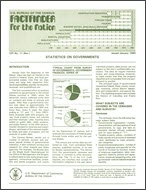
An official website of the United States government
Here’s how you know
Official websites use .gov
A .gov website belongs to an official government organization in the United States.
Secure .gov websites use HTTPS
A lock (
) or https:// means you’ve safely connected to the .gov website. Share sensitive information only on official, secure websites.
-
//
- Census.gov /
- Publications /
- Factfinder for the Nation: Statistics on Governments
Factfinder for the Nation: Statistics on Governments
Factfinder for the Nation: Statistics on Governments
Introduction
Almost from the beginning of this Nation, there has been an interest in the country’s Federal, State, and local governmental bodies: how they are organized and what their respective functional responsibilities, payrolls, tax structure, revenues, and expenditures are.
The first concerted effort to produce statistics on governments in the United States occurred in 1840, when the decennial census collected some data on numbers and kinds of schools and pupils. After that, a governments census was taken at approximately 10-year intervals from 1850 to 1942 and, since then, every 5 years (for years ending in “2” and “7,” from 1957). Early censuses dealt with property values, local property taxes, and schools and their revenues. Later, inquiries were added on public debt, utility systems, and public finance. In the 20th century, interest focused on revenues and expenditures; estimates of the national wealth, by State and class of property; and the analysis of public debt.
The Census Bureau carries out a number of periodic surveys and prepares special studies of governmental statistics. It also conducts surveys and research for other Federal and State agencies. For example, the Bureau acts as the Single Audit Clearinghouse for the Office of Management and Budget; it collects data on law-enforcement management, correctional facilities, probation and parole programs, and courts for the Department of Justice; and it analyzes the movement of Federal pass-through funds within and for the various States.
The census and survey data are collected by mail, from centralized State sources, published records, or on site by Bureau representatives. The returns from the governments censuses and surveys, in contrast to other enumerations that Title 13 of the U.S. Code requires, are voluntary and, except for information collected in the past about individual property sales prices, are not subject to the law’s confidentiality provisions. The data do require intensive review and cross-checking, however, to make certain that they are properly classified and comparable from one government to another.
The principal types of governments covered are Federal, State, county, municipal, township, school district (dependent and independent), and special district. This statistical program also includes the District of Columbia and Puerto Rico.
Others in Series
Publication
Publication
Publication
Share
Related Information
Some content on this site is available in several different electronic formats. Some of the files may require a plug-in or additional software to view.
 Yes
Yes
 No
NoComments or suggestions?


Top

